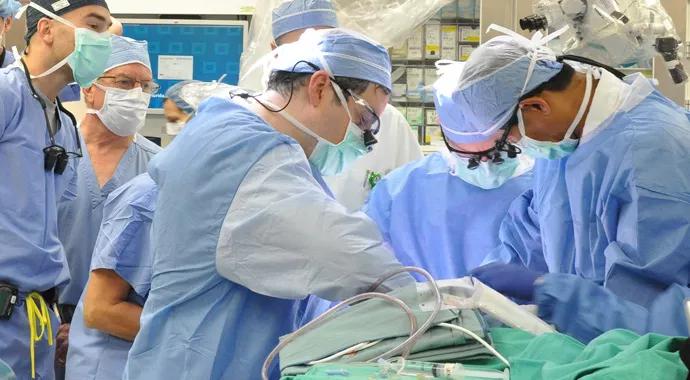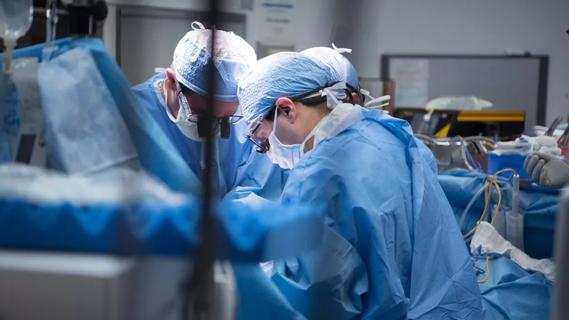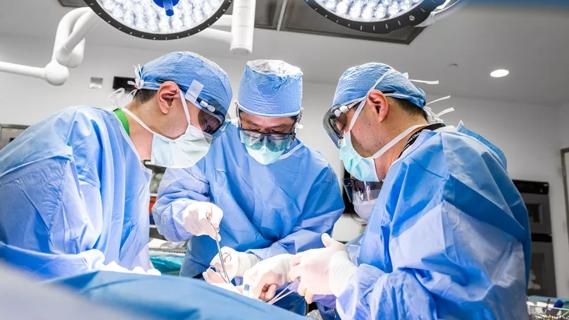Sorting out who does what among the many players

By Francis A. Papay, MD
Cleveland Clinic is a non-profit academic medical center. Advertising on our site helps support our mission. We do not endorse non-Cleveland Clinic products or services. Policy
“Healthcare is a team sport.” We hear that so often these days that it’s easy to lose sight of what it really means. Then a case comes along that jolts us and teaches us anew the marvels that can be accomplished when healthcare is delivered with truly exceptional teamwork.
Such a case came along more than a month ago at Cleveland Clinic when we performed our second near-total face transplant.
The procedure, performed in a middle-aged man who suffered facial trauma and other complications as a result of a motor vehicle accident, is detailed in this related post. I want to add a few words here about the multidisciplinary team that made it happen, the many intersecting roles involved and the ethic of cooperative innovation that is essential to successful face transplantation.
By their nature, face transplants and other forms of vascularized composite tissue transplantation require more multispecialty expertise than most solid-organ transplants simply because of the multiplicity of tissue types and organs involved. Below is a rundown of some of the many key players who took part in our recent near-total face transplant.
Plastic surgeons and surgical assistants made up the core of the surgical teams that harvested the tissue graft from the donor and transplanted it in the recipient. Nine surgeons with specialty expertise in plastic surgery participated in the 24.5-hour procedure, along with two surgical assistants. The surgeons were:
Head and neck surgeons — Two of our plastic surgeons, myself and Dr. Brian Gastman, are board-certified in both otolaryngology and plastic surgery, which gives us helpful added experience in head and neck reconstruction, including the ability to achieve facial nerve reanimation when needed. Additionally, Drs. Gaby Doumit and James Zins added to our team’s depth with their craniomaxillofacial training and wealth of experience. We are also privileged to be able to call on colleagues from Cleveland Clinic’s Neurological Institute for specialized nerve-related consultation, though that has not been necessary in our two face transplants to date.
Microvascular surgeons — Several members of our plastic surgery team (Drs. Steven Bernard, Risal Djohan, Mark Hendrickson and Graham Schwarz) brought to bear their specialty interest in microvascular surgery to deftly handle small blood vessels and connect the conduits of blood supply to the face. Beyond expert understanding of the microvasculature, these surgeons bring the technical skills that come only from doing many hundreds of microvascular procedures.
Immunologists and immunosuppression specialists — Key contributors in this arena include Kareem Abu-Elmagd, MD, PhD, Director of Cleveland Clinic’s Transplant Center and a world-renowned transplant surgeon and immunosuppression expert, and Bijan Eghtesad, MD, a liver transplant surgeon with exquisite expertise in immunosuppression. Dr. Abu-Elmagd consulted the team on adjusting the patient’s pre-existing immunosuppressant therapy in advance of the transplant (see related post for case details), and Dr. Eghtesad has been the steady, judicious manager of the patient’s post-transplant immunosuppression, keeping him free of rejection episodes thus far.
Ophthalmologists — As detailed in the case profile, our team had to race against the progressive destruction of the patient’s eyelids to try to preserve the vision in his one remaining eye while he waited for a donor face graft. Retina experts and ocuplasty and extraocular muscle specialists from Cleveland Clinic’s Cole Eye Institute were essential to our success thus far in saving the patient’s vision. They will be called on down the road for another operation to better position the eye in its orbit and perhaps for an eventual corneal transplant to further improve his vision.
Research staff — Renowned face transplant researcher Maria Siemionow, MD, PhD, has remained a consultant and advisor to Cleveland Clinic for this case, and her ideas helped shape our approach to it and will guide the reporting of insights gained under the Department of Defense’s AFIRM grant that supported the case (see case profile for details). Additionally, two new plastic surgeons at Cleveland Clinic — Bahar Bassiri Gharb, MD, PhD, and Antonio Rampazzo, MD, PhD — brought their research in the microvascular anatomy of the face to bear to help us maximize the safety and robustness of the donor facial graft.
Psychiatrist and bioethicists — Verifying patient understanding of informed consent and the potential physical and emotional trauma involved in a transplant may be more critical and complex in face transplant than in any other transplant type. We and the patient were guided at every step of this process by psychiatrist Kathy Coffman, MD, who specializes in working with transplant recipients, and bioethicists Eric Kodish, MD, and Susannah Rose, PhD.
Nurses — A dedicated team of specialized nurses provide the patient with expert and watchful care around the clock as his recovery progresses.
Dentist/prosthodontist — The patient will soon be ready to have an obturator placed to plug the hole created in the back of his palate during the surgery, which will allow him to eat solid food again. That obturator will be made and placed by one of the prosthodontists in Cleveland Clinic’s Head & Neck Institute.
Specialists in 3-D modeling — This was the first face transplant we know of that was planned with assistance of 3-D modeling of the blood vessels in the patient’s neck and face. The idea was championed by hepatologist Nizar Zein, MD, who recently pioneered 3-D-printed liver models for transplant planning at Cleveland Clinic, and the modeling work for our face transplant was done by radiologists and biomedical engineers in Cleveland Clinic’s Lerner Research Institute.
Team ethic trumps all
Additional team members included transplant infectious disease specialist Sherif Mossad, MD; a specialized pharmacist dedicated to the case; two anesthesiologists with expertise in transplant cases and head and neck surgery; and too many others to single out in this post. My job as the transplant team co-director was essentially to coordinate the various roles and serve as coach.
One of the lessons I’ve learned in this coaching role is that the relationships among team members — the ability to put aside egos, accept one’s role and support one another — is as important as the team members’ technical skills and clinical knowledge. I am proud that our team performed exceedingly well in this regard, which I believe helps explain why the operation itself was exceptionally smooth from a technical standpoint.
This type of collaborative genius keeps the focus on the most important team member: the patient. He remains the lead actor, and the rest of us are his supporting cast.
Dr. Papay co-directed the transplant team for Cleveland Clinic’s recent near-total face transplant along with consultant and advisor Maria Siemionow, MD, PhD. He is Chair of Cleveland Clinic’s Dermatology & Plastic Surgery Institute and Director of its Center for Reconstructive Transplantation.
Photo credit: ©Janine Sot

Insights from murine models could help guide care for patients

Reviewing how the drug can be incorporated into care

Insights on guiding treatment decisions

Largest, longest analysis to date shows greater weight loss and fewer diabetes medications needed

Strong patient communication can help clinicians choose the best treatment option

ctDNA should be incorporated into care to help stratify risk pre-operatively and for post-operative surveillance

The importance of raising awareness and taking steps to mitigate these occurrences

New research indicates feasibility and helps identify which patients could benefit